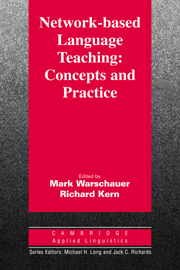Book contents
- Frontmatter
- Contents
- List of contributors
- Series editors' preface
- Preface
- 1 Introduction: Theory and practice of network-based language teaching
- 2 Sociocollaborative language learning in Bulgaria
- 3 On-line learning in second language classrooms: An ethnographic study
- 4 Negotiation in cyberspace: The role of chatting in the development of grammatical competence
- 5 Writing into change: Style shifting in asynchronous electronic discourse
- 6 Computers and collaborative writing in the foreign language curriculum
- 7 Networked multimedia environments for second language acquisition
- 8 An electronic literacy approach to network-based language teaching
- 9 Task-based language learning via audiovisual networks: The LEVERAGE project
- 10 Is networked-based learning CALL?
- Name index
- Subject index
1 - Introduction: Theory and practice of network-based language teaching
Published online by Cambridge University Press: 05 October 2012
- Frontmatter
- Contents
- List of contributors
- Series editors' preface
- Preface
- 1 Introduction: Theory and practice of network-based language teaching
- 2 Sociocollaborative language learning in Bulgaria
- 3 On-line learning in second language classrooms: An ethnographic study
- 4 Negotiation in cyberspace: The role of chatting in the development of grammatical competence
- 5 Writing into change: Style shifting in asynchronous electronic discourse
- 6 Computers and collaborative writing in the foreign language curriculum
- 7 Networked multimedia environments for second language acquisition
- 8 An electronic literacy approach to network-based language teaching
- 9 Task-based language learning via audiovisual networks: The LEVERAGE project
- 10 Is networked-based learning CALL?
- Name index
- Subject index
Summary
Since the early 1960s, language teachers have witnessed dramatic changes in the ways that languages are taught. The focus of instruction has broadened from the teaching of discrete grammatical structures to the fostering of communicative ability. Creative self-expression has come to be valued over recitation of memorized dialogues. Negotiation of meaning has come to take precedence over structural drill practice. Comprehension has taken on new importance, and providing comprehensible input has become a common pedagogical imperative. Culture has received renewed interest and emphasis, even if many teachers remain unsure how best to teach it. Language textbooks have begun to distinguish spoken and written language forms, and commonly incorporate authentic texts (such as advertisements and realia) alongside literary texts. It is in the context of these multifarious changes that one of the most significant areas of innovation in language education computer-assisted language learning (CALL) has come of age. Nowadays, audiotape-based language labs are gradually being replaced by language media centers, where language learners can use multimedia CD-ROMs and laser discs, access foreign language documents on the World Wide Web, and communicate with their teachers, fellow classmates, and native speakers by electronic mail. If language teaching has become more exciting, it has also become considerably more complex.
This book deals with one form of CALL, what we call network-based language teaching (NBLT). NBLT is language teaching that involves the use of computers connected to one another in either local or global networks.
- Type
- Chapter
- Information
- Network-Based Language Teaching: Concepts and PracticeConcepts and Practice, pp. 1 - 19Publisher: Cambridge University PressPrint publication year: 2000
- 88
- Cited by



